How to Freeze Custard Apple? 6 Easy Steps!
To freeze custard apples effectively, begin by selecting ripe but firm fruits. Ensure they are washed and dried to avoid bacterial growth.
Peel and deseed the custard apples, as the flesh is the only part you’ll want to preserve. Segments can be prepped for freezing to maintain their taste and texture.
Use airtight, freezer-safe containers for storage to maximize shelf life. This method ensures you have delicious custard apple available at your convenience.
Freezing custard apples is a great way to extend their shelf life and enjoy their sweetness year-round.
The process involves selecting ripe, firm custard apples, washing and drying them, peeling, deseeding, and then preparing the fruit for freezing.
Proper storage in freezer-safe containers is crucial to maintain the quality of the fruit. By following these steps, you can ensure that your custard apples remain flavorful and retain their texture, even after being frozen.
Here are some quick steps:
By prepping and storing correctly, custard apples can be preserved without losing much of their original taste and texture.
Enjoy your custard apples all year round by freezing them with this simple and effective method.
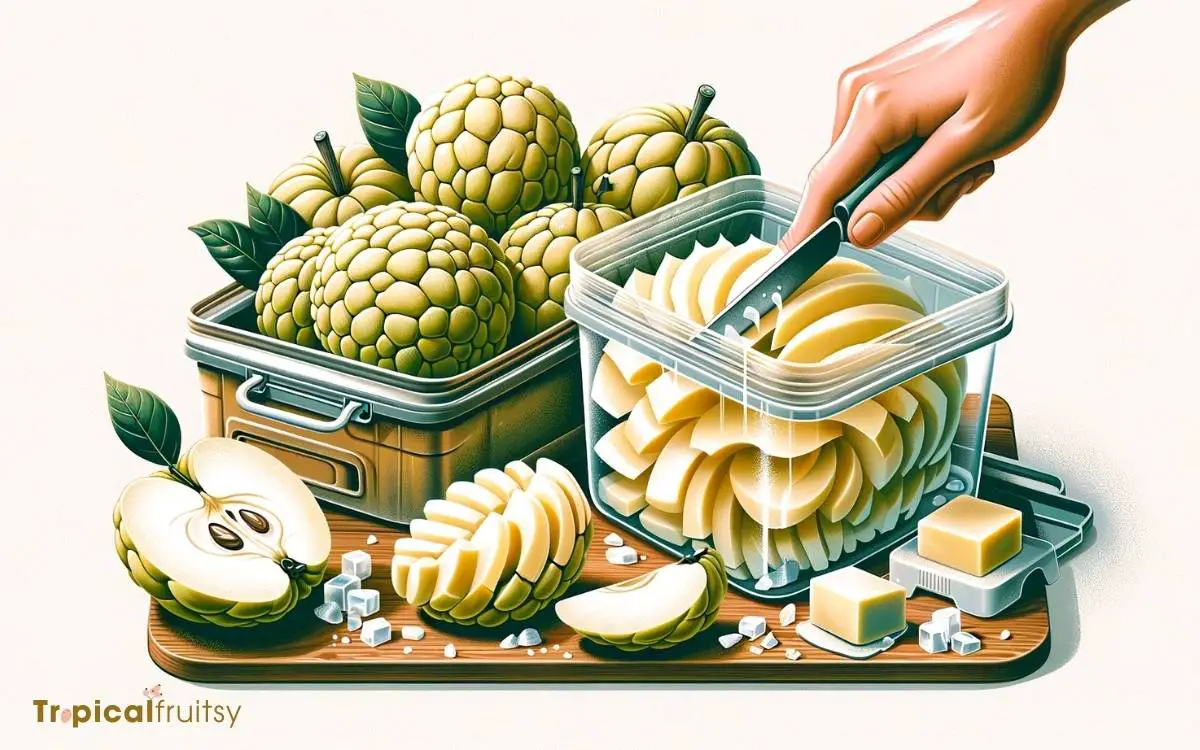
Key Takeaway
Step 1: Selecting the Right Fruit
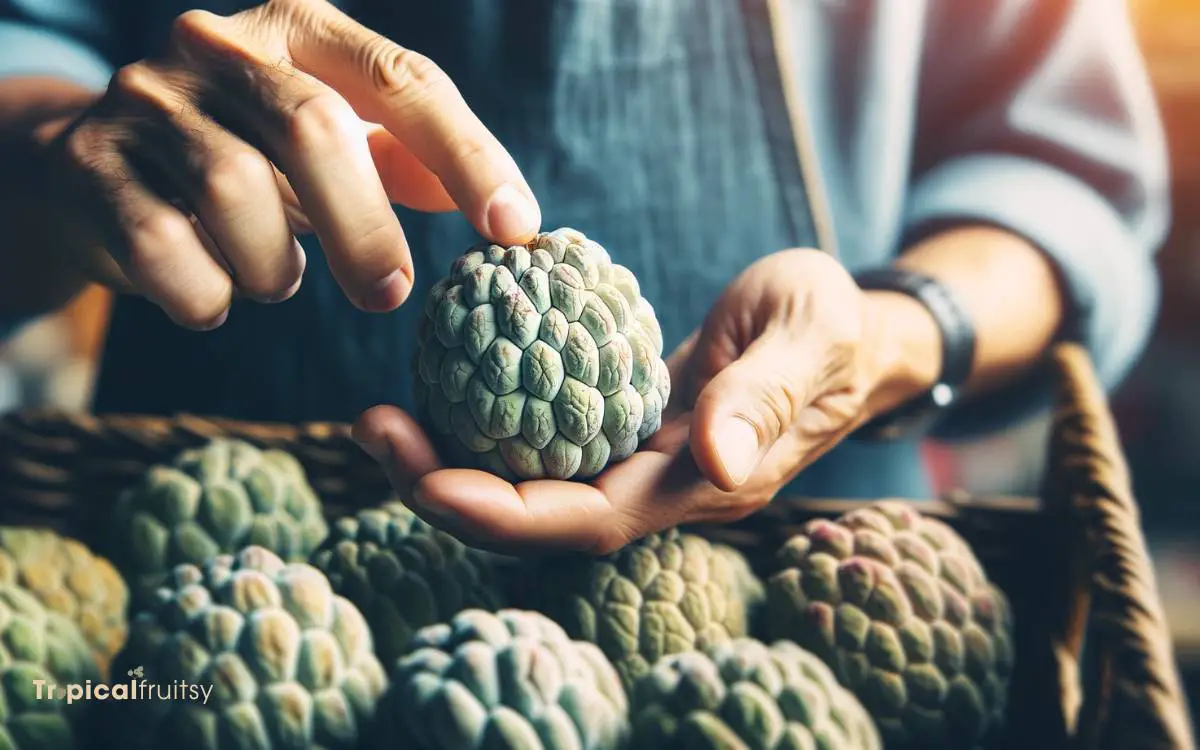
I choose ripe, blemish-free custard apples for freezing to ensure optimal flavor and texture preservation. It’s crucial to assess the fruit’s ripeness; a slight give under gentle pressure indicates it’s at peak maturity.
Overripe fruits tend to have a compromised cellular structure, which doesn’t withstand the freezing process well, leading to a mushy defrosted product.
Underripe fruits, conversely, can be excessively tart and may not develop the full spectrum of sweetness even after thawing.
Innovative freezing techniques, such as flash freezing individual segments, can be employed to maintain the fruit’s integrity.
Ensuring the selected custard apples are free of imperfections minimizes the risk of spoilage and bacterial growth during storage.
Step 2: Washing and Cleaning
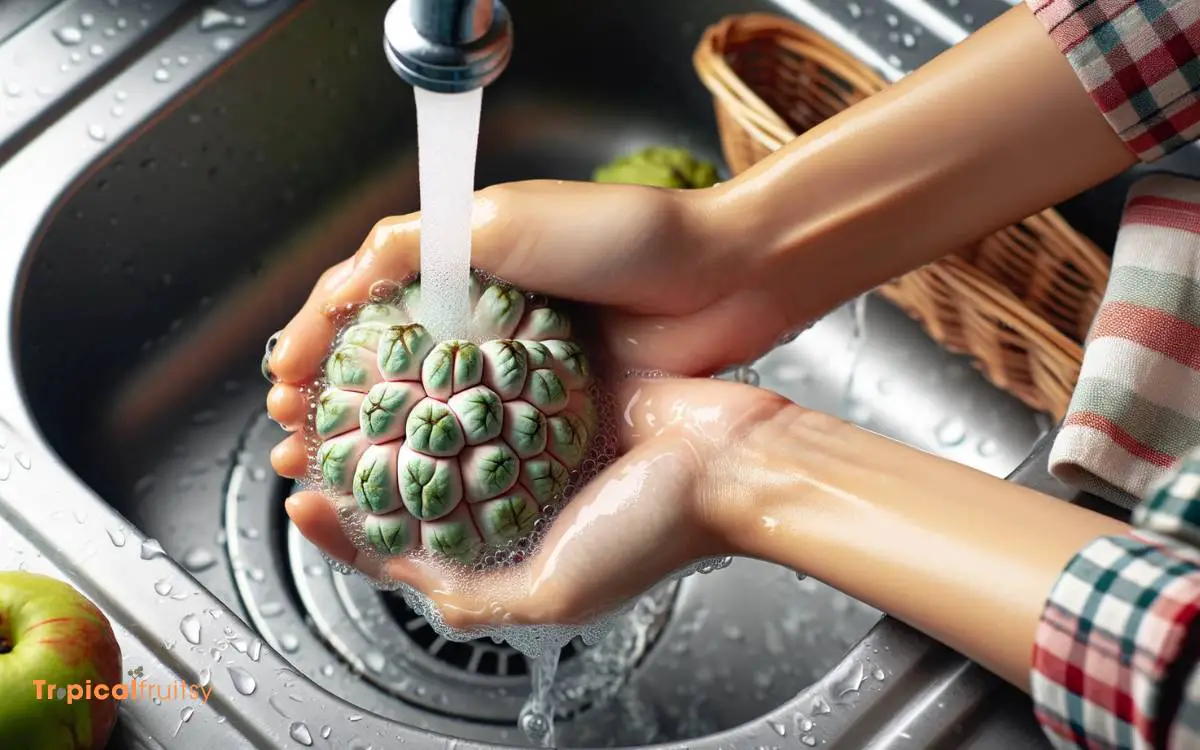
Before freezing custard apples, I ensure they’re impeccably clean to maintain flavor and safety. I’ve refined my rinse techniques to effectively eliminate any surface contaminants or pesticide residues.
This process includes a careful removal of the skin’s natural residue, setting the stage for optimal preservation.
Rinse Techniques
Every custard apple must be thoroughly rinsed to remove any residues or dirt before freezing. I’ve found that simply running water over the fruit isn’t enough.
Instead, I use a gentle scrubbing technique with a soft brush under lukewarm water. This ensures that all nooks and crannies are reached, dislodging any hidden debris.
After scrubbing, I prepare a vinegar solution—using a ratio of one part vinegar to three parts water—as an additional cleansing step.
I immerse the custard apples for a couple of minutes, which helps to eliminate bacteria and potential pesticides. Once soaked, I rinse them again under running water to wash away the vinegar.
This meticulous cleaning process is essential for safety and maintaining the fruit’s quality during freezing.
Removing Skin Residue
After the initial rinse, I carefully peel away the custard apple’s skin, ensuring that any remaining residue is completely removed before freezing.
It’s imperative to eliminate all traces of the outer layer, as it can harbor unwanted bacteria or chemicals that might compromise the fruit’s purity and flavor.
I meticulously inspect each segment, searching for any lingering bits of skin or dirt. My movements are deliberate, aiming to preserve the integrity of the custard apple’s flesh, which is prone to bruising.
Once I’m satisfied with the cleanliness, I pat the fruit dry with a lint-free towel. This step is crucial; moisture can lead to ice crystal formation, which degrades the custard apple’s texture upon thawing.
The preparation is now set for the freezing process.
Step 3: Peeling and Deseeding
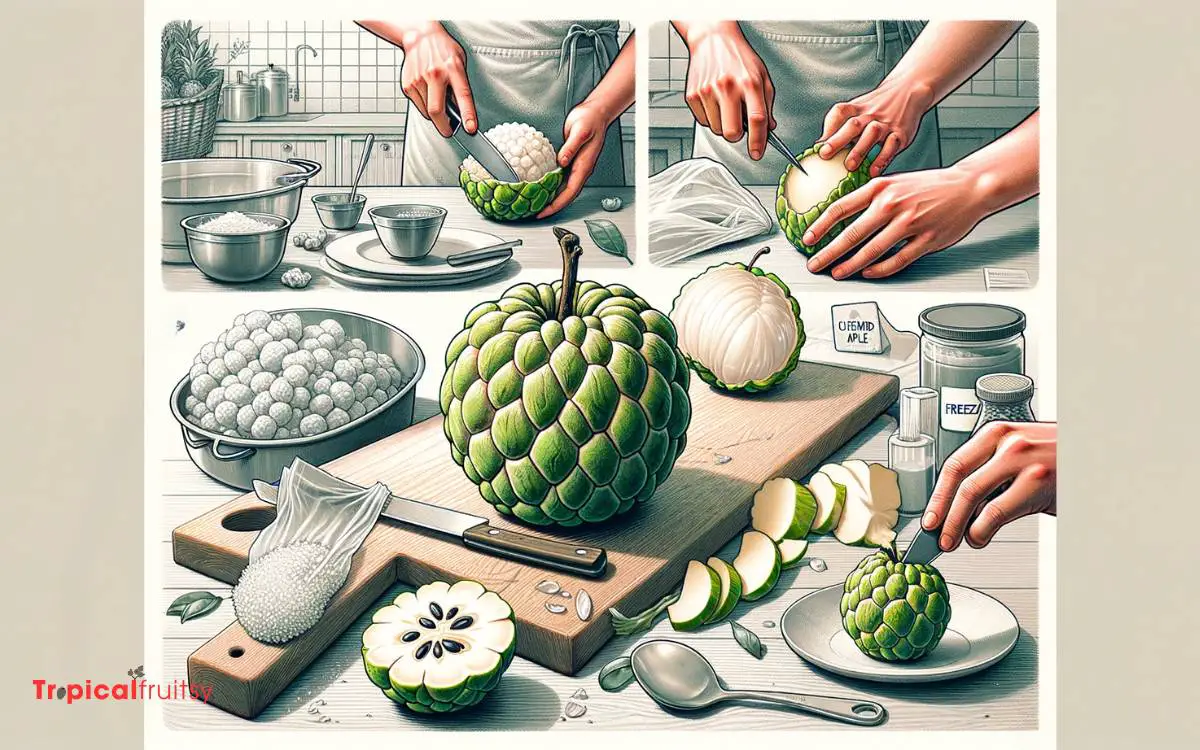
In preparing custard apples for freezing, I first peel the skin and remove the seeds with care to ensure optimal texture and flavor preservation.
The act of peeling is a meticulous process; I use a sharp paring knife, cutting away from the body to minimize the risk of injury.
For deseeding, I adopt a methodical approach, bisecting the fruit to expose the seed-laden pulp. Then, with precision, I dislodge each seed, ensuring none remain embedded in the creamy flesh.
It’s imperative that I conduct this task diligently; seeds left behind can impart a bitter taste when thawed.
Thus, the fruit is prepped, ready for its subzero slumber, with its essence impeccably intact for future enjoyment.
Step 4: Pre-Freezing Preparation
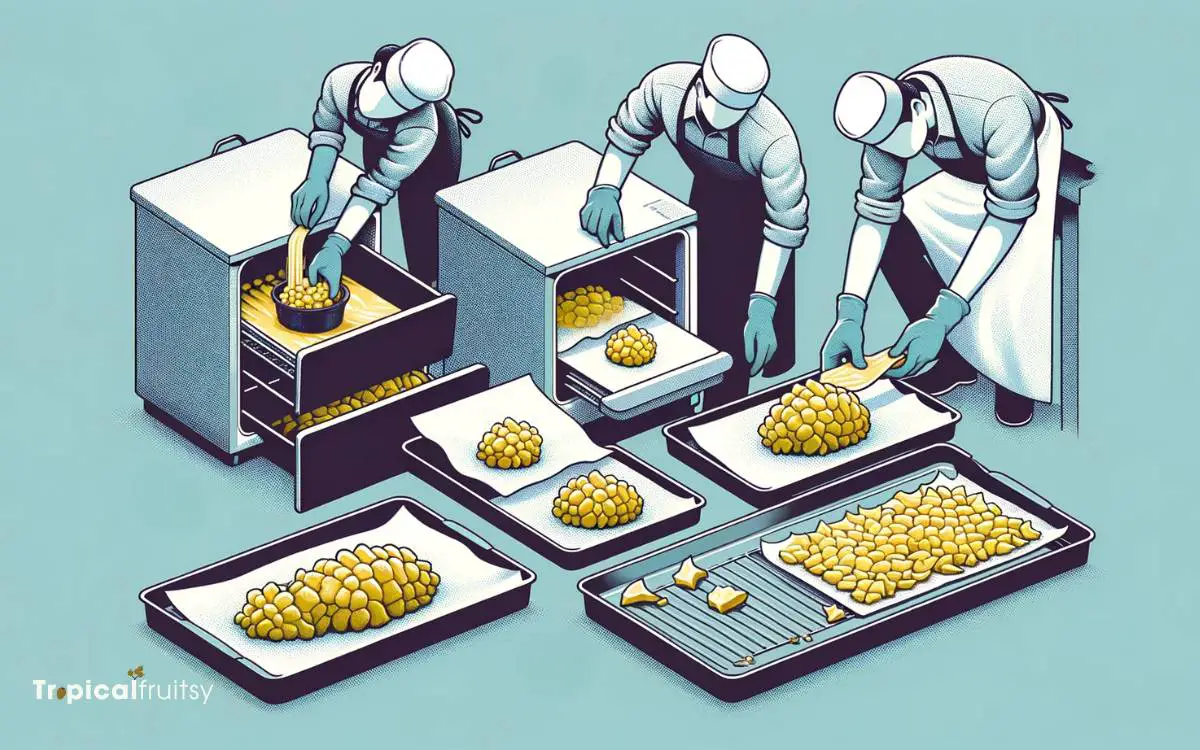
Having prepped the custard apple’s flesh, I now turn to ensuring it’s appropriately packaged for freezing. The goal is to preserve its quality while preventing freezer burn and texture degradation.
Here’s my meticulous approach:
- Choice of Container: I opt for airtight, freezer-safe containers or bags. These must be rigid enough to protect the delicate flesh yet flexible enough to accommodate expansion as the fruit freezes.
- Portioning: I divide the fruit into single-use portions. This strategy prevents thawing more than needed, maintaining freshness and reducing waste.
- Labeling: Each package receives a clear label with the date and contents. This aids in inventory management and ensures I use the oldest stock first, adhering to sensible food rotation practices.
Step 5: Storing in Freezer-Safe Containers
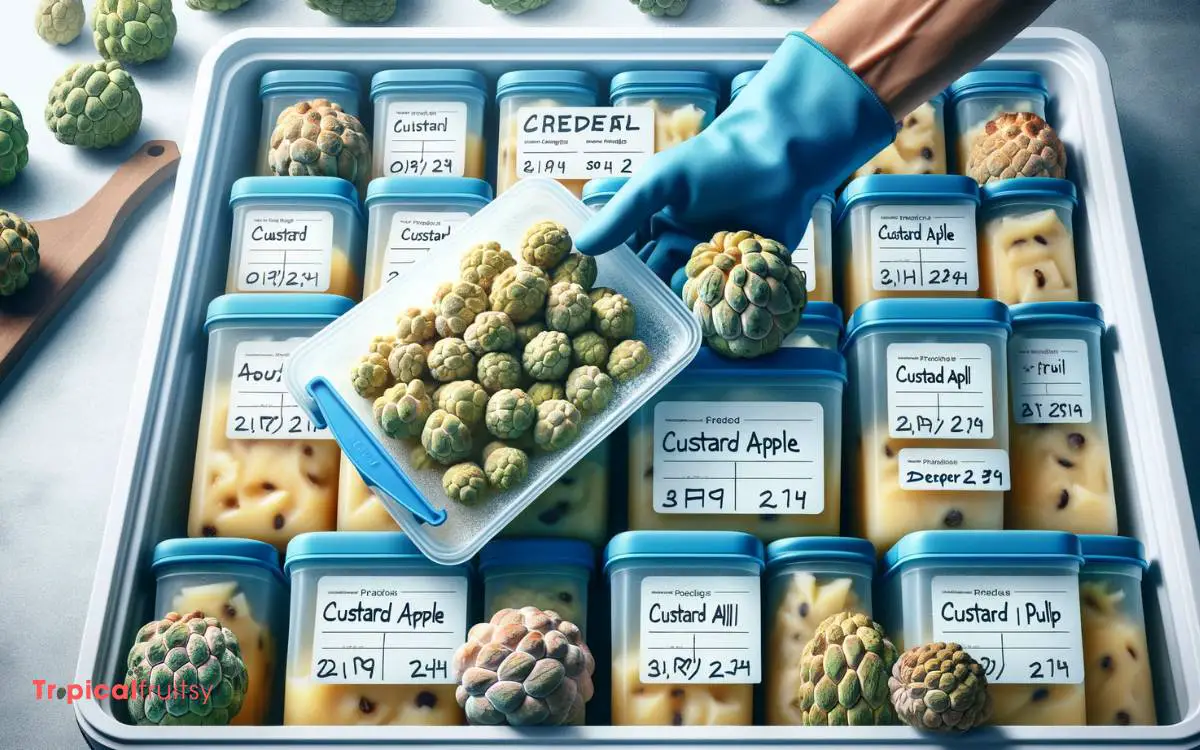
Once I’ve prepped my custard apples, selecting the right container is crucial for freezing. I analyze container options to ensure they’re airtight, which is pivotal for maintaining the fruit’s freshness over time.
Container Selection
I ensure my custard apples are well-preserved by using airtight, freezer-safe containers to prevent freezer burn and flavor loss.
The selection process is critical, and I consider several factors:
- Material Durability: I opt for containers made of thick plastic or glass that can withstand low temperatures without cracking.
- Seal Integrity: The lids must seal tightly. I perform a simple test by closing the lid and ensuring no air can escape.
- Size Appropriateness: It’s important to choose a container size that matches the quantity of custard apple to minimize air exposure.
Adhering to these criteria ensures that my custard apples retain their taste and texture when thawed. It’s a strategic approach to maintain their quality for future enjoyment.
Pre-Freezing Preparation
Before transferring my custard apple into the containers, I wash and dry the fruit thoroughly to remove any residue. I then meticulously segment the fruit, excising the flesh from the skin and seeds with surgical precision.
This preparatory step necessitates a methodical approach to preserve the purity of the custard apple’s flavor and texture.
Next, I allocate the pulp into pre-labeled, freezer-safe containers, each portion carefully measured to ensure consistency and convenience for future use.
| Emotion | Before Freezing | After Freezing |
|---|---|---|
| Anticipation | Fresh, vibrant custard apple | Access to off-season delight |
| Satisfaction | Orderly, labeled containers | Hassle-free future usage |
| Contentment | Pristine fruit preparation | Preserved taste and texture |
This systematic procedure not only streamlines the process but also enriches the sensory experience upon eventual thawing. With the custard apple now securely stored, I turn my focus toward maximizing freshness retention.
Maximizing Freshness Retention
To ensure that the custard apple retains its delectable freshness, I’m careful to choose containers that are specifically designed for freezing.
It’s not just about preventing freezer burn; it’s about preserving the fruit’s texture, flavor, and nutritional value.
Here’s my strategy:
- Airtight Seal: I opt for containers with a robust sealing mechanism. This minimizes oxygen exposure, preventing oxidative spoilage.
- Proper Sizing: I select a container size that matches the quantity of custard apple, ensuring minimal air space. Too much air can lead to ice crystal formation, which degrades quality.
- Material Durability: Containers made from heavy-duty plastic or glass designed for low temperatures are my go-to. They resist cracking and guard against odors and flavors transferring between foods.
Step 6: Thawing and Using Frozen Custard Apples
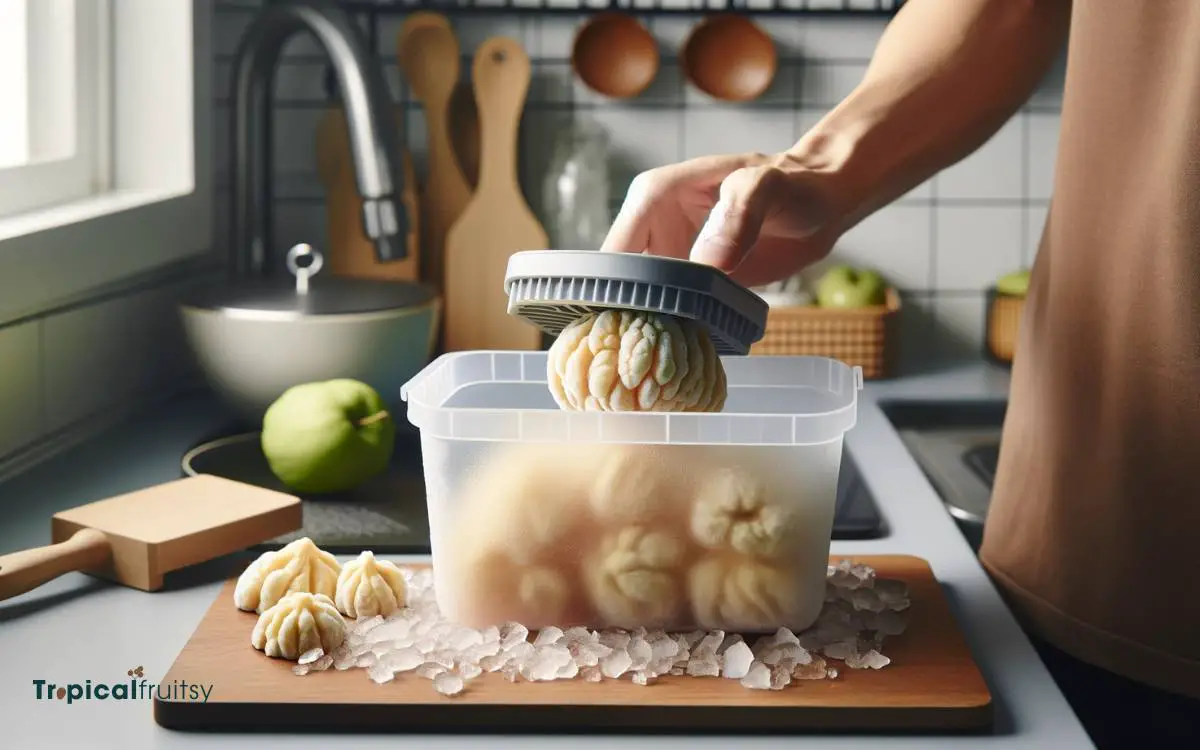
When you’re ready to enjoy your frozen custard apples, it’s crucial to thaw them properly to preserve their texture and flavor.
Thawing should be a controlled process; hence, I recommend transferring the fruit from the freezer to the refrigerator several hours before use, allowing a gradual temperature increase.
This mitigates the risk of texture degradation that rapid temperature shifts can induce. For immediate use, a quick-thaw technique involves placing the custard apple in a sealed plastic bag and immersing it in cold water.
However, be aware this method may slightly compromise the fruit’s structural integrity. Once thawed, the custard apples are best consumed promptly, ensuring peak freshness and taste.
Can I Freeze Custard Apple After Cleaning It?
Yes, you can freeze custard apple after cleaning it. To clean custard apple easily, simply remove the skin and seeds, then cut the pulp into chunks. Place the chunks in an airtight container or freezer bag to freeze for up to three months. Thaw before using.
Tips for Long-Term Storage
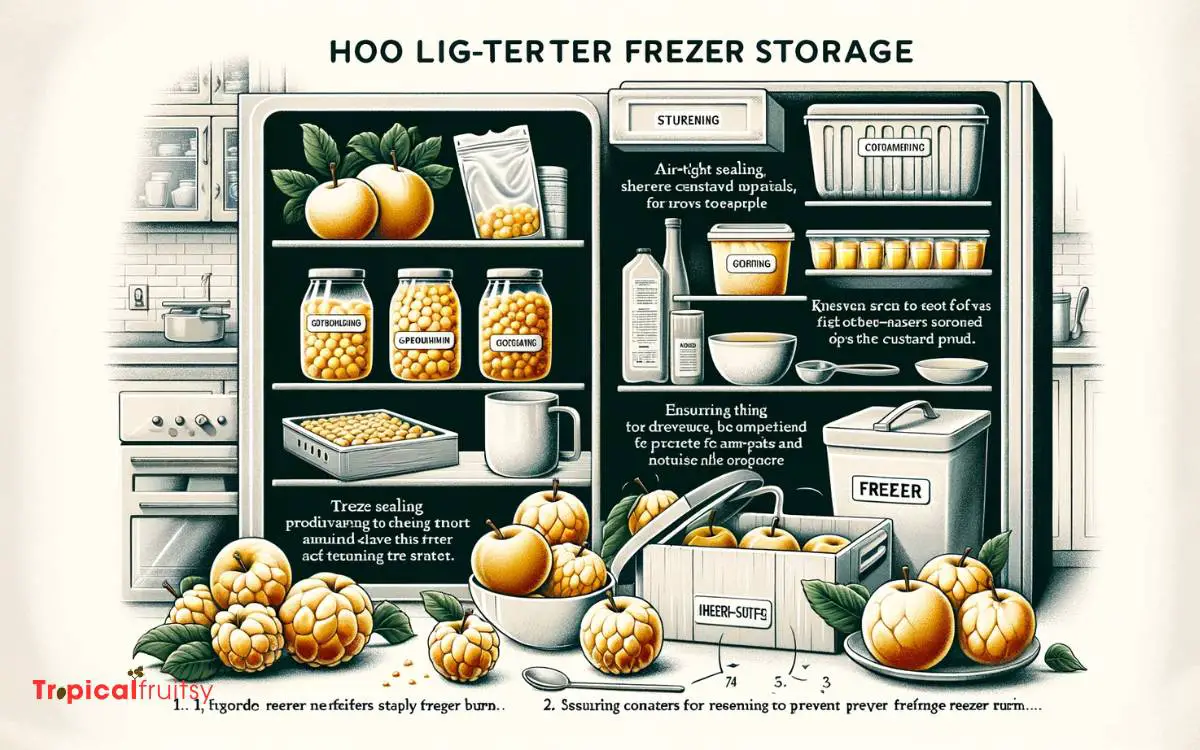
I’ll guide you through the best practices for storing custard apples in the freezer, ensuring they remain fresh and flavorful for months.
To maintain their quality, consider these factors:
- Temperature Consistency: Store custard apples at a stable -18°C (0°F). Fluctuations can cause ice crystals, damaging texture and flavor.
- Airtight Packaging: Use vacuum-sealed bags or airtight containers. Oxygen exposure leads to freezer burn, which diminishes taste and nutritional value.
- Pre-Freezing Preparation: Wash, peel, and slice the fruit before freezing. This step reduces preparation time when you’re ready to use them and keeps the pieces from sticking together.
How to Store Custard Apple Pulp
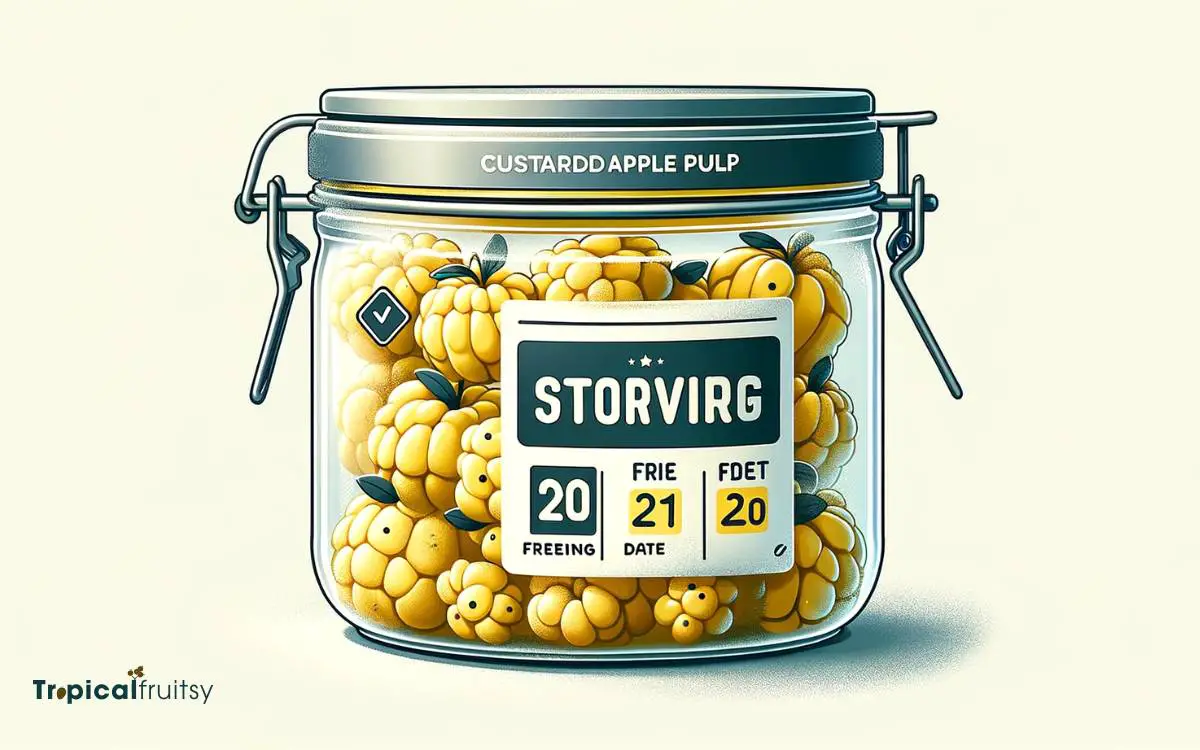
Storing custard apple pulp properly can help you enjoy its delicious flavor and nutritional benefits for a longer time.
Here are steps on how to store custard apple pulp:
Extract the Pulp:
- Start by selecting ripe custard apples. You can tell they are ripe when the fruit’s skin yields to gentle pressure, and it gives off a sweet aroma.
- Cut the custard apple in half, and scoop out the pulp and seeds with a spoon. Be careful to remove the seeds, as they are not edible.
Store in an Airtight Container:
- Place the extracted custard apple pulp in an airtight container or a glass jar with a tight-fitting lid. Make sure the container is clean and dry.
- Fill the container with the custard apple pulp, leaving a small space at the top to allow for expansion and to minimize air exposure.
Add Lemon Juice (Optional):
- To prevent the custard apple pulp from turning brown due to oxidation, you can add a little lemon juice to it. Lemon juice contains ascorbic acid (vitamin C), which acts as an antioxidant and helps preserve the color and freshness of the pulp.
Seal the Container:
- Seal the container tightly to prevent air from entering, which can cause the pulp to spoil faster.
Refrigerate:
- Place the airtight container with the custard apple pulp in the refrigerator. Storing it at a cool temperature helps extend its shelf life.
- Custard apple pulp can typically be kept in the refrigerator for 2-3 days while maintaining its quality and flavor.
Freezing (Optional):
- If you want to store custard apple pulp for a more extended period, you can freeze it.
- To freeze, place the pulp in an airtight container or freezer-safe bag, removing as much air as possible to prevent freezer burn.
- Label the container or bag with the date and store it in the freezer. Custard apple pulp can be stored in the freezer for several months.
Thawing:
- When you’re ready to use the frozen custard apple pulp, transfer it to the refrigerator to thaw overnight. Avoid using a microwave for thawing, as it may affect the texture and flavor.
Keep in mind that the texture of custard apple pulp may change slightly after freezing and thawing, but it can still be used in smoothies, desserts, or as a topping.
Proper storage techniques help preserve the flavor and nutritional content of the pulp.
Conclusion
In sum, securing the sweetness of custard apples through freezing is simple yet strategic. I’ve picked pristine pieces, prepped patiently, and packed them perfectly in protective pouches.
Thawing them thoughtfully transforms them back to tropical treats. With these tidbits of wisdom, I’ve wielded the wherewithal to whisk these wonders into winter, warranting their worth well beyond their season.
Freezing fruit, fundamentally, is an art—an alignment of attention and action, ensuring each exquisite experience endures.






